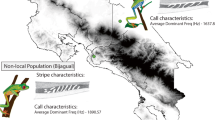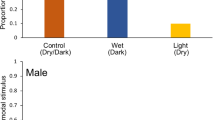Abstract
Mate selection in heterogeneous sensory environments may be challenging. Assessing the suitability of potential partners may be compromised if individual characteristics cannot be assessed reliably across all encountered conditions. The problem is particularly acute in a species recognition context if matings with heterospecific partners yield lower fitness than matings with conspecific partners of low quality. Multimodal communication may circumvent this problem by transmitting redundant information on several channels that are not affected by the same degradation processes (Backup hypothesis). We addressed this issue in two hybridizing newts (Lissotriton helveticus and L. vulgaris) for which visual species recognition is disrupted in water stained by humic acids, a common family of compounds produced by decaying vegetation. Because these species also use olfaction for sexual communication, we predicted that species recognition was maintained in stained water when olfactory information was available. Results did not support the prediction of the backup hypothesis. Species recognition was observed in the clear water treatment only, and the olfactory channel seemed to carry only limited additional information. Two mechanisms may account for the small contribution of olfaction to species recognition. (1) Females may have a lower sensory capacity to discriminate between olfactory than between visual signals. (2) Divergence between olfactory signals may be lower than divergence between visual signals. Resorting to multimodal communication does not seem to allow efficient discrimination across all environmental conditions. Therefore, we predict that hybridization rate would vary between habitats depending on water color.



Similar content being viewed by others
References
Arnold ML, Hodges SA (1995) Are natural hybrids fit or unfit relatives to their parents? Trends Ecol Evol 10:67–70
Arnold ML, Martin NH (2013) Hybrid fitness across time and habitats. Trends Ecol Evol 25:530–536
Arntzen JW, de Wijer P, Jehle R, Smit J (1998) Rare hybridization and introgression in smooth and palmate newts (Salamandridae: Triturus vulgaris and T. helveticus). J Zool Syst Evol Res 36:111–122
Badayev AV, Hill GE, Weckworth BV (2002) Species divergence in sexually selected traits: increase in song elaboration is related to decrease in plumage ornamentation in finches. Evolution 56:412–419
Bolker BM, Brooks ME, Clark CJ, Geange SW, Poulsen JR, Stevens MH, White J-SS (2009) Generalized linear mixed models: a practical guide for ecology and evolution. Trends Ecol Evol 24:127–135
Borgia G (1993) The cost of display in the non-resource based mating system of the Satin Bowerbird. Am Nat 141:729–743
Bradbury JN, Vehrencamp SC (1998) Principles of animal communication. Sinauer, Sunderland
Bro-Jorgensen (2010) Dynamics of multiple signalling systems: animal communication in a world in flux. Trends Ecol Evol 25:292–300
Candolin U, Salesto T, Evers M (2007) Changed environmental conditions weaken sexual selection in sticklebacks. J Evol Biol 20:233–239
Castellano S, Cermelli P (2006) Reconciling sexual selection to species recognition: a process-based model of mating decision. J Theor Biol 242:529–538
Cole GL (2013) Lost in translation: adaptation of mating signals in changing environments. Springer Sci Rev 1:25–40
Colganiceanu D (1994) The relative importance of vision and olfaction in mate recognition in male newts (genus Triturus). Herpetologica 50:344–349
Crump D, Lean D, Berrill M, Coulson D, Toy L (1999) Spectral irradiance in pond water: influence of water chemistry. Photochem Photobiol 70:893–901
Denoël M, Doellen J (2010) Displaying in the dark: light-dependent alternative mating tactics in the Alpine newt. Behav Ecol Sociobiol 64:1171–1177
Dukas R (2006) Learning decreases heterospecific courtship and mating in fruit flies. Biol Lett 4:645–647
Fabian NJ, Albright LB, Gerlach G, Fisher HS, Rosenthal GG (2007) Humic acid interferes with species recognition in zebrafish (Danio rerio). J Chem Ecol 33:2090–2096
Fisher HS, Wong BBM, Rosenthal GG (2006) Alteration of the chemical environment disrupts communication in a freshwater fish. Proc R Soc Lond B 273:1187–1193
Gilliard ET (1956) Bower ornamentation versus plumage characters in bowerbirds. Auk 73:450–451
Grafe TU, Wanger TC (2007) Multimodal signaling in male and female foot-flagging frogs Staurois guttatus (Ranidae): an alerting function of calling. Ethology 113:772–781
Grafe TU, Preininger D, Sztatecsny M, Kasah R, Dehling JM, Proksch S, Hödl W (2012) Multimodal communication in a noisy environment: a case study of the Bornean rock frog Staurois parvus. PLoS ONE 7:e37965
Grant PR, Grant BR (1992) Hybridization of bird species. Science 256:193–197
Halliday TR (1977) The courtship of European newts: an evolutionary perspective. In: Taylors DH, Guttman SI (eds) The reproductive biology of amphibians. Plenum Press, New York, pp 185–232
Hebets EA, Papaj DR (2005) Complex signal function: developing a framework of testable hypotheses. Behav Ecol Sociobiol 57:197–214
Hebets EA, Vink CJ, Sullivan-Beckers L, Rosenthal MF (2013) The dominance of seismic signaling and selection for signal complexity in Schizocosa multimodal courtship displays. Behav Ecol Sociobiol 67:1483–1498
Hubbard PC, Barata EN, Canario VM (2002) Possible disruption of pheromonal communication by humic acid in the goldfish, Carassius auratus. Aquat Toxicol 60:169–183
Johanet A, Secondi J, Lemaire C (2011) Widespread introgression does not leak into allotopy in a broad sympatric zone. Heredity 106:962–972
Johnson KP (1999) The evolution of bill coloration and plumage dimorphism the transference hypothesis in dabbling ducks. Behav Ecol 10:63–67
Johnstone RA (1996) Multiple displays in animal communication :`backup signals’ and `multiple messages’. Philos Trans R Soc Lond B 351:329–338
Maia R, Eliason CM, Bitton P-P, Doucet SM, Shawkey MD (2013) pavo: an R package for the analysis, visualization and organization of spectral data. Methods Ecol Evol 4:906–913
Mendelson TC, Shaw KL (2012) The (mis) concept of species recognition. Trends Ecol Evol 27:421–427
Mesquita R, Canario AVM, Melo E (2003) Partition of fish pheromones between water and aggregates of humic acids. Consequences for sexual signaling. Environ Sci Technol 37:742–746
Morris DP, Zagarese H, Williamson CE, Balseiro EG, Hargreaves BR, Modenatti B, Moeller R, Queimalinos C (1995) The attenuation of solar UV radiation in lakes and the role of dissolved organic carbon. Limnol Oceanogr 40:1381–1391
Muñoz NE, Blumstein DT (2012) Multisensory perception in uncertain environments. Behav Ecol 23:457–462
Ornelas JF, González C, Espinosa De Los Monteros A (2009) Uncorrelated evolution between vocal and plumage coloration traits in the trogons: a comparative study. J Evol Biol 22:471–484
Partan SR (2013) Ten unanswered questions in multimodal communication. Behav Ecol Sociobiol 67:1523–1539
Partan S, Marler P (1999) Communication goes multimodal. Science 283:1272–1273
Partan SR, Marler P (2005) Issues in the classification of multimodal communication signals. Am Nat 166:231–245
Pfennig KS (1998) The evolution of mate choice and the potential for conflict between species and mate-quality recognition. Proc R Soc Lond B 265:1743–1748
Pfennig KS (2007) Facultative mate choice drives adaptive hybridization. Science 318:965–967
Preininger D, Boeckle M, Freudmann A, Starnberger I, Sztatecsny M, Hödl W (2013) Multimodal signaling in the Small Torrent Frog (Micrixalus saxicola) in a complex acoustic environment. Behav Ecol Sociobiol 67:1449–1456
R Core Team (2014) R: A language and environment for statistical computing.—R Foundation for Statistical Computing, Vienna. URL: http://www.R-project.org
Randler C (2002) Avian hybridization, mixed pairing and female choice. Anim Behav 63:103–119
Rowe C (1999) Receiver psychology and the evolution of multicomponent signals. Anim Behav 58:921–931
Rowe C, Guilford T (1996) Hidden colour aversions in domestic chicks triggered by pyrazine odours of insect warning displays. Nature 383:520–522
Ryan MJ, Rand AS (1993) Species recognition and sexual selection as a unitary problem in animal communication. Evolution 47:647–657
Secondi J, Théry M (2014) An ultraviolet signal generates a conflict between sexual selection and species recognition in a newt. Behav Ecol Sociobiol 68:1049–1058
Secondi J, Aumjaud A, Pays O, Boyer S, Montembault D, Violleau D (2007) Water turbidity affects the development of sexual morphology in the palmate newt. Ethology 113:711–720
Secondi J, Hinot E, Djalout Z, Sourice S, Jadas-Hecart A (2009) Realistic nitrate concentration alters the expression of sexual traits and olfactory male attractiveness in newts. Funct Ecol 23:800–808
Secondi J, Johanet A, Pays P, Cazimajou F, Djalout Z, Lemaire C (2010) Olfactory and visual species recognition in newts and their role in hybridization. Behaviour 147:1693–1712
Secondi J, Lepetz V, Théry M (2012) Male attractiveness is influenced by UV wavelengths in a newt species but not in its close relative. PLoS ONE 7:e30391
Secondi J, Okassa M, Sourice S, Théry M (2014) Habitat-dependent species recognition in hybridizing newts. Evol Biol 41:71–80
Seehausen O (2004) Hybridization and adaptive radiation. Trends Ecol Evol 19:198–207
Seehausen O, Takimoto G, Roy D, Jokela J (2008) Speciation reversal and biodiversity dynamics with hybridization in changing environments. Mol Ecol 17:30–44
Selz OM, Pierotti MER, Maan ME, Schmid C, Seehausen O (2014) Female preference for male color is necessary and sufficient for assortative mating in 2 cichlid sister species. Behav Ecol 25:612–626
Shurtliff QR (2011) Mammalian hybrid zones: a review. Mamm Rev 43:1–21
Shutler D, Weatherhead PJ (1990) Targets of sexual selection: song and plumage of wood warblers. Evolution 44:1967–1977
Siddall EC, Marples NM (2008) Better to be bimodal: the interaction of color and odor on learning and memory. Behav Ecol 19:425–432
Spurway H, Callan HG (1960) The vigour and male sterility of hybrids between the species Triturus vulgaris and T. helveticus. J Genet 57:84–118
Sullivan BK (2009) Mate recognition, species boundaries and the fallacy of “species recognition”. Open Zool J 2:86–90
Taylor RC, Ryan MJ (2013) Interactions of multisensory components perceptually rescue tungara frog mating signals. Science 341:273–274
Treer D, Van Bocxlaer I, Matthijs S, Du Four D, Janssenswillen S, Willaert B, Bossuyt F (2013) Love is blind: indiscriminate female mating responses to male courtship pheromones in newts (salamandridae). PLoS ONE 8:e56538
Uetz GW, Roberts JA, Clark DL, Gibson JS, Gordon SD (2013) Multimodal signals increase active space of communication by wolf spiders in a complex litter environment. Behav Ecol Sociobiol 67:1471–1482
van der Sluijs I, Gray SM, Amorim MCP, Barber I, Candolin U, Hendry A, Krahe R, Maan ME, Utne-Palm AC, Wagner H-J, Wong BM (2011) Communication in troubled waters: responses of fish communication systems to changing environments. Evol Ecol 25:623–640
Wiens JJ (2001) Widespread loss of sexually selected traits: how the peacock lost its spots. Trends Ecol Evol 16:517–523
Wilgers DJ, Hebets EA (2011) Complex courtship displays facilitate male reproductive success and plasticity in signaling across variable environments. Curr Zool 57:175–186
Wong BBM, Candolin U, Lindström K (2007) Environmental deterioration compromises socially enforced signals of male quality in three-spined sticklebacks. Am Nat 170:184–189
Acknowledgments
This study was conducted with the approval of Préfecture de Maine-et-Loire (permit 15/2013) and in accordance with the current laws in France. It was funded by ANR-2011-BSV7-001 Project SENSHYBLE.
Author information
Authors and Affiliations
Corresponding author
Rights and permissions
About this article
Cite this article
Secondi, J., Rodgers, G., Bayle, F. et al. Mate preference, species recognition and multimodal communication in heterogeneous environments. Evol Ecol 29, 217–227 (2015). https://doi.org/10.1007/s10682-014-9744-5
Received:
Accepted:
Published:
Issue Date:
DOI: https://doi.org/10.1007/s10682-014-9744-5




